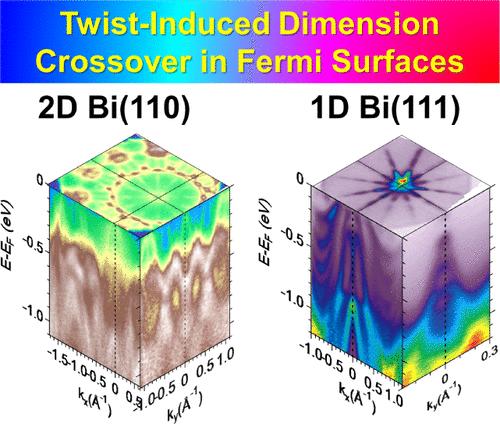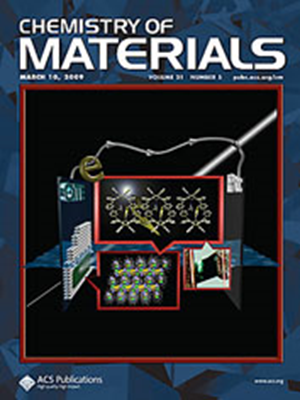Twist-Induced Dimensional Crossover and Topological Phase Transitions in Bismuthene Quasicrystals
IF 7.2
2区 材料科学
Q2 CHEMISTRY, PHYSICAL
引用次数: 0
Abstract
Twisted bismuthene homojunctions, comprised of a Bi(111) bilayer atop two Bi(110) monolayers, exhibit a distinct growth orientation that is facilitated by self-assembly. Our cross-sectional structural analysis reveals an unexpected growth alignment of Bi(110) layers on transition-metal dichalcogenides, deviating from the anticipated Bi(111) bilayer structure. This self-assembly process, driven by the crystal symmetry interplay, induces a topological phase transition beyond a critical thickness. The dimensional crossover in the Fermi surfaces marks the electronic transition from two-dimensional (2D) Bi(110) to 1D Bi(111) quasicrystals. Additionally, the emergence of the topologically nontrivial band structures, an enhanced 1D carrier density, and a metal–insulator transition through band inversion indicate that the twisted bismuthene quasicrystals are promising candidates for higher-order topological quasicrystalline insulators. These findings pave the way for low-resistance contacts in 2D transistors, advancing the development of next-generation electronic devices.

由两个 Bi(110) 单层上的 Bi(111) 双层组成的扭曲双钌同质结在自组装的作用下呈现出独特的生长方向。我们的横截面结构分析表明,过渡金属二卤化物上的 Bi(110) 层的生长排列出乎意料,偏离了预期的 Bi(111) 双层结构。在晶体对称性相互作用的推动下,这种自组装过程在超过临界厚度时诱发了拓扑相变。费米面的维度交叉标志着从二维(2D)Bi(110) 到一维 Bi(111) 准晶体的电子转变。此外,拓扑非奇异带状结构的出现、1D 载流子密度的增强以及通过带反转实现的金属-绝缘体转变表明,扭曲双钌准晶体有望成为高阶拓扑准晶体绝缘体。这些发现为二维晶体管中的低电阻接触铺平了道路,推动了下一代电子器件的发展。
本文章由计算机程序翻译,如有差异,请以英文原文为准。
求助全文
约1分钟内获得全文
求助全文
来源期刊

Chemistry of Materials
工程技术-材料科学:综合
CiteScore
14.10
自引率
5.80%
发文量
929
审稿时长
1.5 months
期刊介绍:
The journal Chemistry of Materials focuses on publishing original research at the intersection of materials science and chemistry. The studies published in the journal involve chemistry as a prominent component and explore topics such as the design, synthesis, characterization, processing, understanding, and application of functional or potentially functional materials. The journal covers various areas of interest, including inorganic and organic solid-state chemistry, nanomaterials, biomaterials, thin films and polymers, and composite/hybrid materials. The journal particularly seeks papers that highlight the creation or development of innovative materials with novel optical, electrical, magnetic, catalytic, or mechanical properties. It is essential that manuscripts on these topics have a primary focus on the chemistry of materials and represent a significant advancement compared to prior research. Before external reviews are sought, submitted manuscripts undergo a review process by a minimum of two editors to ensure their appropriateness for the journal and the presence of sufficient evidence of a significant advance that will be of broad interest to the materials chemistry community.
 求助内容:
求助内容: 应助结果提醒方式:
应助结果提醒方式:


